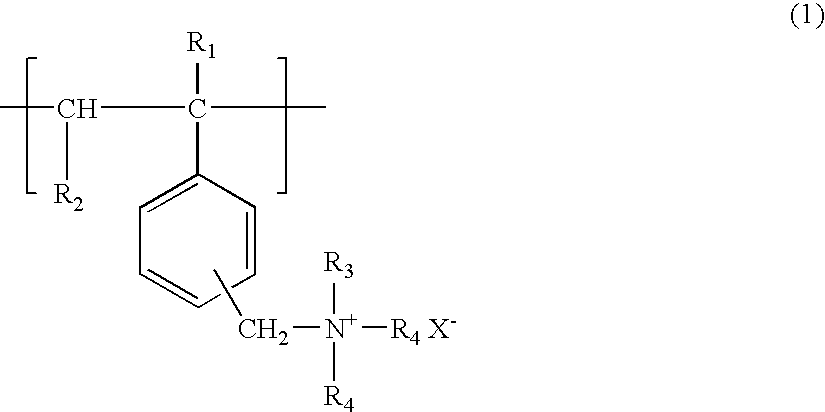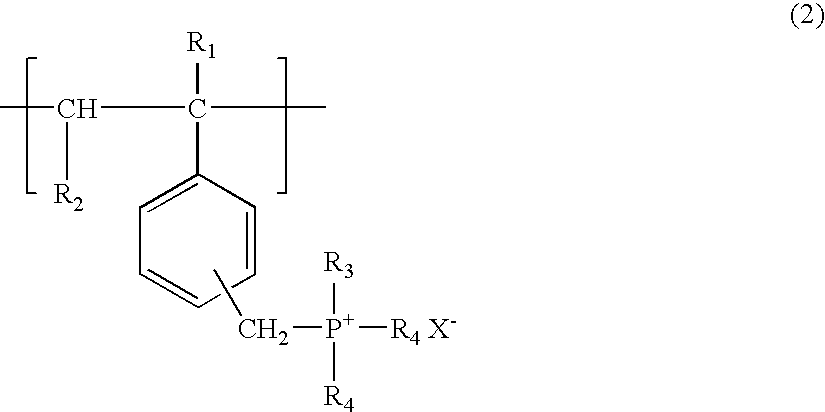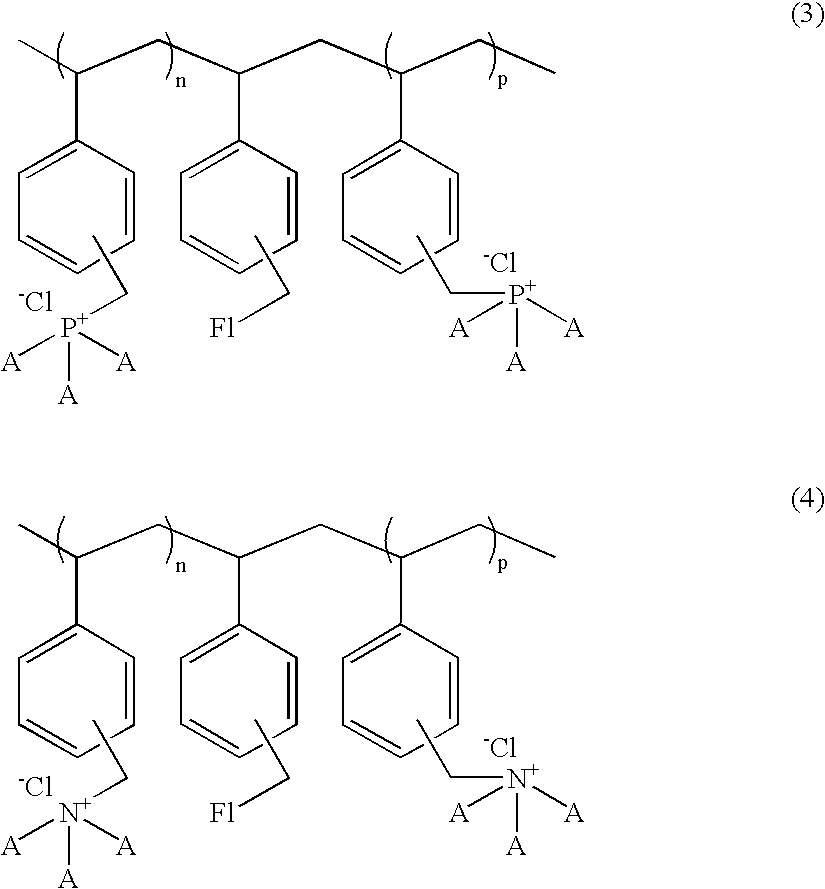Polymeric ammonium and or phosphonium salts having added pi-electrons and higher molecular weight as enhancers for chemiluminescent systems
a phosphonium salt and ammonium technology, applied in the field of polymer ammonium and phosphonium salts, can solve the problems of not teaching cross-linked polymers, prior art does not disclose the use of water-insoluble or partially water-soluble polymers or organic solvent-soluble polymers of ammonium and phosphonium, and poor quantitative yield of 1,2-dioxetanes in aqueous media, and achieves the effect of improving chemiluminescen
- Summary
- Abstract
- Description
- Claims
- Application Information
AI Technical Summary
Benefits of technology
Problems solved by technology
Method used
Image
Examples
example i
[0076]This example illustrates the preparation of the reaction product of polyvinylbenzyl chloride and trioctylphosphine (Water insoluble or soluble in organic solvents polymer):
[0077]In a 500 ml round bottom flask was dissolved 5.0 parts of polyvinylbenzyl chloride in 150 ml of anhydrous dimethylformamide. To this was added 15 parts of trioctylphosphine in one portion under nitrogen. The reaction mixture was stirred at room temperature for 48 hours and then at 45° C. for 2-3 hours. The dimethylformamide was evaporated under reduced pressure at 50-55° C. and the viscous solid was washed with ether (3×200 mL) to give a solid, water-insoluble, organic solvent soluble product, which was dried under nitrogen to a yield of 11.0 parts.
example ii
[0078]Reaction of polyvinylbenzyl chloride and tributylphosphine and trioctylphosphine; partially water soluble polymer:
[0079]Following the procedure of Example I, 5.0 parts of polyvinylbenzyl chloride in 150 ml of anhydrous dimethylformamide was reacted with 15 parts of trioctylphosphine. After the reaction was completed, 5.0 parts of tributylphosphine was added in one portion. The reaction mixture was stirred at room temperature for 48 hours and at 45° C. for 2-3 hours. After cooling, the reaction mixture was poured into a 900 mL mixture of ether and hexane (1:1). The solvent was removed and the viscous solid was washed with ether (3×150 mL) to give a solid which was dried under nitrogen, to a yield of 9.7 parts of a partially water-soluble polymer.
example iii
[0080]Reaction of polyvinylbenzyl chloride and fluorescein, tributylphosphine and trioctylphosphine (partially water soluble fluorescent polymer):
[0081]In a 500 mL round bottom flask was dissolved 5.0 parts of polyvinylbenzyl chloride in 150 mL of anhydrous dimethylformamide to which was added 0.6 parts of fluorescein. The reaction mixture was heated at 70-75° C. for 48 hours. After cooling the mixture to room temperature, 15 parts of trioctylphosphine was added to the reaction flask in one portion under nitrogen and the reaction mixture was stirred at room temperature for 48 hours and then at 45° C. for 2-3 hours. Then 5.0 parts of tributylphosphine was added as described in Example I in one portion. After cooling, the mixture was poured into a 900 mL mixture of ether and hexane (1:1). The solvent was then removed and the residual viscous solid was washed with ether (3×150 mL) to give a solid which was dried under nitrogen to a of 9.25 parts.
PUM
| Property | Measurement | Unit |
|---|---|---|
| temperature | aaaaa | aaaaa |
| temperature | aaaaa | aaaaa |
| temperature | aaaaa | aaaaa |
Abstract
Description
Claims
Application Information
 Login to View More
Login to View More - R&D
- Intellectual Property
- Life Sciences
- Materials
- Tech Scout
- Unparalleled Data Quality
- Higher Quality Content
- 60% Fewer Hallucinations
Browse by: Latest US Patents, China's latest patents, Technical Efficacy Thesaurus, Application Domain, Technology Topic, Popular Technical Reports.
© 2025 PatSnap. All rights reserved.Legal|Privacy policy|Modern Slavery Act Transparency Statement|Sitemap|About US| Contact US: help@patsnap.com



